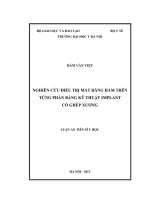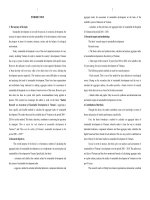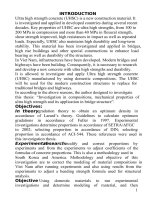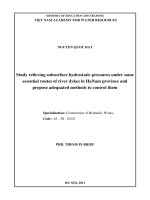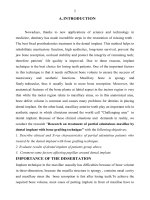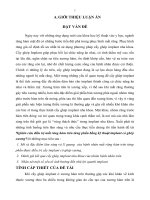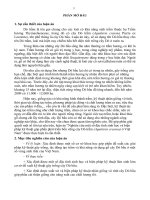tóm tắt tiếng anh nghiên cứu điều trị mất răng hàm trên từng phần bằng kỹ thuật implant có ghép xương
Bạn đang xem bản rút gọn của tài liệu. Xem và tải ngay bản đầy đủ của tài liệu tại đây (262.6 KB, 25 trang )
1
A. INTRODUCTION
Nowadays, thanks to new applications of science and technology in
medicine, dentistry has made incredible steps in the restoration of missing teeth .
The best fixed prosthodontics treatment is the dental implant. This method helps to
rehabilitate masticatory function, high aesthetics, long-term survival, prevent the
jaw bone resorption, occlusal stability and protect the integrity of remaining teeh;
therefore patients’ life quality is improved. Due to these reasons, implant
technique is the best choice for losing teeth patients. One of the important factors
in this technique is that it needs sufficient bone volume to ensure the success of
masticatory and aesthetic functions. Maxillary bone is spongy and
finely trabecular, thus it usually leads to more bone resorption. Moreover, the
anatomical features of the bone plante at labial aspect in the incisor region is very
thin while the molar region relate to maxillary sinus, so in this anatomical area,
bone defect volume is common and causes many problems for dentists in placing
dental implant. On the other hand, maxillary anterior teeth play an important role in
aesthetic aspect in which clinicians around the world call ”Challenging area” in
dental implant. Because of those clinical situations and demands in reality, we
conduct the research "Research on treatment of partial edentulous maxillae by
dental implant with bone grafting technique” with the following objectives:
1. Describe clinical and X-ray characteristics of partial edentulous patients who
treated by the dental implant with bone grafting technique.
2. Evaluate results of dental implant of patients group above.
3. Comment some factors affecting papillae around dental implant.
IMPORTANCE OF THE DISSERTATION
Implant technique in the maxillae ussually has difficulties because of bone volume
in three-dimension, because the maxilla structure is spongy , contains nasal cavity
and maxillary sinus the bone resorption is fast after losing teeth.To achieve the
required bone volume, most cases of putting implant in front of maxillae have to
2
graft onto the bone surface or sinus lift in the posterior area. The factors: bone
width, keratinized mucosa, time after prosthesis, connection design and surface
treatment of the implant neck area affect the bone resorption and the papillae size
around the implant that is still a matter to be examined and identified to contribute
planning the implant in order to achieve best results.
PRACTICAL IMPLICATIONS AND NEW CONTRIBUTIONS
1. Being the research to evaluate results of implant with grafting mixing
autografts and nondemineralized, free dried bone allografts in patients with partial
edentulous maxillae. In Vietnam, there are no such study about implant for only
maxillae up to now. Therefore these research’s results confirmed the necessity and
the science of this apexic.
2. Factors affect the papilae size around implant: soft tissue biotype, time,
keratinized mucosa and bone resorption level.
3. Research conducted putting implant and grafting mixing autologous
bone and free dried bone allografts, then assessed by X-ray and Periotest machine
which showed good bone osseointegration.
4. Applying CT.cone beam film in planning and assessing treatment results is
the best method now. Using Periotest machine to avaluate bone integrating level is
safe and highly reliable.
5. Closed sinus augmentation technique by opening the sinus floor is the safe
and well stable method.
DESSERTATION STRUCTURE
Beside introduction, conclusion and recommendation parts, the dessertation
includes 4 chapters: Overview of research issues: 38 pages. Objects and
Methodology: 21 pages. Results: 30 pages. Discussion: 40 pages. The dessertation
has 34 tables, 7 diagrams, 72 images and 172 references (10 in Vietnamese and 162
in English).
3
B. DESSERTATION’S CONTENT
Chapter 1. OVERVIEW
1.2. The changes of edentulous ridge after losing teeth: Teeth and attached tissue
of cementum,periodontal ligament and bone bunch make a functional unit. Thus
masticatory force is tranmitted from crowns through tooth roots and attached
tissues to supported hard tissues in the alveolar bone. Losing teeth lead to
significant decrease of edentolous ridge size. It is the reason why implanting
usually combined bone grafting techniques in order to ensure the reasonable bone
volume around the implant.
1.3. Osseointegration : Be the direct connection of the structure and function
betwwen Implant and surrounding bone structure.
1.4. Bone grafting materials: Bone grafting materials have many different
purposes in bone regeneration: Support for membrane, act like a flame to develope
bone, stimulate bone growth, be a mechanical barrier against pressure from the soft
tissue covering above, etc. They include some kinds of bone grafting materials and
biological membranes:
- Bone grafting materials: Autograft, allograft, xenografts , alloplastics.
- Biological membranes: Collagen membrane, PTFE membrane, Titanium
membrane.
1.6.Histological processing in bone grafting procedure: The healing and
regeneration of grafting bone includes three mechanisms: Contact osteogenesis,
osteoconduction, osteoinduction. Bone regenerating procees must have one of
there mechanisms involved in.
1.7. Bone grafting techniques
1.7.1. Grafting bone regeneration with guides (GBR): Over the past 20 years,
there has been a significant progress in the development of the GBR technique in
dental Implant field. GBR has become a basic technique in regenerating the defects
of alveolar bones which makes it possible to perform implant for patients. This
progress is an important part of fast development of dental Implant over time.
1.7.2. Bone grafting and Sinus lift technique: Sufficient bone is the main factor
for the success of dental implant in the maxillae. If the bone height between sinus
4
floor to maxillary edentulous ridge crest is less than 10 mm , the bone grafting to
lift sinus floor or alveolar bone graft should be conducted to be able to place
implant ≥ 10mm in diameter and make prosthesis. Now with better equipment such
as Piezoelectric or safe sinus-lift kits, sinus augmentation is safer and safer, then
indicating bone graft for sinus augmentation to implant is more popular.
1.8. Soft tissue characteristics around implant:Surface of the mucosa around
the implant is also covered by keratinized mucosa and thin epithelial barrier (like
junctional epithelim surrounding tooth) opposited healing abutment. The width of
the epithelium barrier consists of only a few layers of cells and its end point located
approximately 2mm from the tip of soft tissue contour and 1-1.5mm from the
edentulous ridge crest. Connective tissues on the bone contact directly with the
surface (TiO2) of the implant. Collagen fibers in the connective tissues derive from
the periosteum of edentulous ridge crest and extend to the soft tissue contour.
Vascular system of the muscosa around the implant is mainly from the
supraperiosteal blood vessels on the outside of the alveolar ridge. These blood vessels
put out branches which supply the Alveolar mucosa, then put forth numerous
branches to the subepithelial plexus, located immediately beneath the oral
epithelium of the free and attached gingiva. The connective tissues of trans-
mucosal attachment on the implant surface contain a few blood vessels and all of
them are determined as the end branches on the periosteum.
1.9. How to connect and handle neck-area implant technique to reduce
bone resorption level: Neck area of the implant bears biggest impacts on its
surrounding bone structure and is usually vanised bone before and after bearing
impacts. Base on biological principles, there is always bone resorption around the
implant. Albertktson and colleagues (1986) suggested that the implant is considered
successful if the degree of bone resorption is 1mm in the 1st year and 0.2 mm for
each next year. Today, with technology progress, the bone resorption level has been
reduced much. One of important factors is that the design to change the connecting
position between the Implant and Presthesis abutment (called Platform Switching
or Platform Shifitng ) and surface treatment of the implant neck area with Laser.
1.11. Successful percentage of the dental implant: By surface-treatment
technology, research of variable and convenient connecting form as well as
5
equipment and materials used in bone graft , positive results in bone defect applied
GBR technique, simplier and safer sinus augmentation technique, the implant field
has been developed strongly recently, and the successful percentage in the implant
is going to 100% which are the incentives for Clinician in this field.
Chapter 2. Objects and Methodology
2.1. Research objects
Research objects are patients who are 18 years old and over, lose partial
maxillae and are implanted with nondemineralized, freeze-drying allogeneic bone
plots mixed with autologous bone grafts , the surgeries have been conducted at the
Hanoi National Hospital of Odonto-Stomatology from 2009 – 2012.
2.1.1. Selective criteria
- Patients with partial edentulous maxillae whose the height of useful bone
was 5.5to under 10 mm in posterior area and ≥ 10 mm in anterior area, the
minimum width of bone was 4mm, the minimum distance is 6mm, the gap from
bone crest to surface of opposite teeth was ≥ 5mm
- Voluntarily agreed to participate in the study.
2.1.2. Exclusion criteria:
- Patients with contraindications with implant such as: cardiovascular
diseases, diabetes and maxillary sinus diseases.
- Completely edentulous patients
- Patients have undergone radiation therapy in the head-face-neck area.
2.2. Research time and place: From 1/2009 to 3/2009 at Implant Department of
Hanoi National Hospital of Odonto – Stomatology.
2.3. Methodology
2.3.1. Research design: Controlled experimental study
2.3.2. Method to identify model size
- Model size calculation formula:
2
2
2
2/1
∆
=
−
s
Zn
α
6
In which: n (model size), s (standard deviation), Δ (estimated error),
2
2/1
α
−
Z
is
confidence coefficient = 1.96 (standard unit in the meaning ofα = 0.05). According to
Linkevicius study (2009), using standard deviation and estimated error which were
0.164 and 0.03 respectively gave the results that the minimum model size was 115. In
fact, we conducted the research on 126 implants of 70 patients.
2.4. Means and research materials.
2.4.1. Implant system.
In this research we used 2 implant systems namely Planton (Japan) and Biohorizons
(America) due to their similare features as following:
- Be similar in diameter and length, the way of inside hexagons connection, tooth
shaped implant with spiral grooves, Titanium alloy material with the same force-
bearing level at 32 – 35 N/cm.
- Both have small diameter implant (3.0 mm) with two components which used for
limited bone width anterior region. In Vietnam, at the time of reasearch, there were
only these two systems which had such kind of implant.
- They both designed modernly and suit with current trends for the conservation
purposes of bone and soft tissues around the implant. Planton system was designed
to connect implant and abutment to increase the amount of connective tissues of
bone crest area, then to protect bone crest from adverse factors (bacteria, toxins,
micro motion, etc) in the oral environment in order to be lower the bone resorption
level. Biohorizons was designed 3mm in neck area with small spiral grooves and
had surface treatment by Laser Lok technology to creat stronger soft tissue
attachment which was called soft tissue intergration to protect bone crest around
implant neck area.
2.4.2. Bone graft materials .
Nondemineralized, freeze-drying allergenic bone used in this research was
Miner Oss bone (America) with 50% of trabecular bone to increase
osteoinductional factors and 50% of cortical bone to mantain during 1 year while
helping new bone grow well. In addition, we always took bone broken during
drilling or in scrapers to use to stimulates bone regeneration ability which only had
in autologous bone. Hence bone defects in this research had all factors of contact
osteogenesis, osteoconduction and osteoinduction ( in the autologous bone and
allogenous bone) to ensure better bone grafting results.
7
- Absorbable collagen membranes with sizes of 10 x 20 mm, 20 x 30 mm or
30 x 40 mm used in the reasearch were called Mem-Lok (America) for Trademark
which had capability of seft-absorption for 26 – 38 weeks. Mem-Lok membranes
had holes with sufficient sizes to assist large molecules to transfer neccessary
nutrients of healing process and easily adapt to variety kinds of bone defects.
2.5. Research Procedure
2.5.1. Clinical examinations.
2.5.2. X-ray screening
2.5.3. Evaluating the defect forms to choose suitable surgery method.
2.5.4. Other clinical tests.
2.5.5. Implant placement
2.5.6. Expose the implant and putting Healing abutment for prosthesis.
2.5.7. Make prosthesis in the labo
2.5.8. Connecting the crown to the abutment
2.8. Data processing: SPSS 16.0 software and some statistical algorithms.
Chapter 3. RESEARCH RESULTS
3.1. Clinical features and X-ray of edentulous region.
3.1.1. Distribution of research subjects by gender and age: The total number
of subjects in this research was 70 patients, in which female: male ratio was 64.3%:
35.7%, average age was 42.2 ± 14.8. There was no difference between male and
female in age groups with p>0.05.
3.1.5. Bone density: D3 bone was the most common type with 68/126 cases
(54%) found mainly in the back teeth. D2 bone accounted for 36.5% with 46/126
cases and concentrated in the front teeth. D4 bone was rare with 12/126 cases ,
equal to 9.5%, and only saw in the back maxillary teeth. There was a relationship
between bone density and maxillary position with p < 0.001.
8
3.1.6. Distribution the location of bone defect
Table 3.9. The distribution of bone defect region in edentulous position
Edentulous
position
Bone defect region
Anterior teeth Posterior teeth General
n % n % n %
Neck
29 59.2 18 23.4 47 37.3
Crown
20
40.8 17 22.1 37 29.4
Apex
0
0.0 42 54.5 42 33.3
Total
49
100.0 77 100.0 126 100.0
p <0.001
bone defect in the implant neck area was met in 47/126 cases accounting for 37.3%.
bone defect in the implant crown area had 37/126 cases with 29.4% and the 3rd type
of bone defect fell into 33.3%. For back teeth, the most popular bone defect region
belonged to implant neck area (59.2%). The difference between bone defect region
and edentulous position had meaning with p<0.001.
3.1.7. Soft-tissue biotype: For anterior teeth, thin soft tisue type was more
popular with 55.1%, while for posterior teeth, thick soft tissue one owned the
largest percent of 53.2%.
3.1.8. Size of dental implant: Main diameter of 3.3-3.8 mm was used most
(46.8%). All 3.0mm main diameter was for front teeth, while 4.6-4.7-5.8 kinds only
applied for back teeth. Bone group of which width was over 9mm was suitable with
4.6-4.7 main diameter accounting for 84.4%, and it was just 60.6% that bone group
with under 6mm width used main diameter of 3.3 – 3.8mm. The relationship
between main diameter and bone width had meaning with p<0.001.
3.2.Implant results
3.2.1. The initial stability
Diagram 3.1.Initially stable level
In the research our initially stable level was over 35N/cm at 66.67% which was two
times higher than the initial stable level of 20-35 N/cm.
3.2.2. Injury status
9
3.2.2.1. Level of pain after surgery: Slightly painful level was at the apex percent
with 39.7%, while painless level was 23% which was seen most in the apex bone
defect region with 19/29 cases or 65.5%. At the crown and neck bone defect region
of dental implant, the moderately painful level accounted for 53.2% and 40.5%
respectively. Whereas, this proportion in the apex bone defect region of implant
was just 16.7%. The differences had statistical meaning with p<0.001.
3.2.2.2. Swelling after surgery: Major cases of bone grafting had swelling reaction
with 87/126 cases (69%). This ratio was lower by the bone defect positions of neck,
crow and apex of implant, namely 48.3%, 33.3% and 18.4% respectively. In the
both two first bone defect positions (neck and crown), the cases of swelling were
always higher than no swelling cases with 89.4% and 78.4%, meanwhile it reversed
in apex. There was a relationship between the posapexerative swelling and bone
defect region with p<0.001.
3.2.2.3. Dehiscence:
Table 3.20.Relationship between dehiscence and bone resorption preprosthesis (in
mm)
Bone resorption
Open wounds
Mesial Distal
P
n
X
± SD
n
X
± SD
Yes
18
0.41 ± 0.12
18
0.43 ± 0.14
>0.05
No
105
0.33 ± 0.08
105
0.32 ± 0.08
>0.05
p 0.005 0.001
Table 3.20 demonstrated that cases of dehiscence during 7-10 days had higher bone
resorption level compared to cases without dehiscence. The differences had
statistical meaning with p=0.005 for mesial side and p= 0.001 for distal side.
10
3.2.3. Bone resorption before prosthesis (in mm):
Table 3.21. Relationship between soft tissues and bone resorption for pre-
prosthesis (mm)
Bone resorption
Soft tissue
Mesial Distal
P
N
X
± SD
n
X
± SD
Thin
60
0.39 ± 0.09
60
0.38 ± 0.11
>0.05
Thick
63
0.29 ± 0.06
63
0.30 ± 0.07
>0.05
p 0.000 0.000
Table 3.21 indicated that patients with thin soft tissue had mean bone resorption level of
0.39 ± 0.09 for mesial side and 0.38 ± 0.11 for distal side. For patients with thick soft
tissue, mean bone resorption level for mesial side was 0.29 ± 0.06 and one for distal
side was 0.30 ± 0.07. The difference between thin and thick bone tissues in bone
resorption level had statistical meaning with p< 0.0001.
3.2.4. The width of keratinzed mucosa:
Table 3.22. Relationship between bone defect region and changes of
keratinzed mucosa width after and before
Osteopenia
position
Width of
keratinized
mucosa
Neck Crown Apex
n
X
± SD
n
X
± SD
n
X
± SD
Before surgery 44
6.45±0.9
6
37
6.62±0.8
7
42
6.89±1.02
After surgery 44
5.05±1.1
3
37
5.37±1.0
42
6.55±0.95
p 0.000 0.000 0.117
Implants inserted in bone defect positions of neck and crown: Changes of the
keratinized mucosa width before and after surgery had statistical meaning with
p<0.05. Implants inserted in bone defect positions of apex: Changes of the
keratinized mucosa width before and after surgery had statistical meaning with
p>0.05.
3.2.6. Successful percent: 97.6%; eliminated percent: 2.4%.
3.2.9. Results on functional rehabilitation: The ability to rehabilitate
masticatory function of implant prosthesis was always good with high proportions
in different points of evaluation which increased by time (77.2%; 90.6%; 94.6% và
11
90%). Poor rehabilitated ability of masticatory function was at lowest percent at
different time of evaluation which decreased by time. Similarly results for aesthetic
rehabilitation ability.
3.2.10. Bone resorption after prosthesis: Bone resorption level rised by time,
but the periods between bone resorption times were shorter. The difference
had statistical meaning with p<0.05
0.723
0.639
0.538
0.412
0
0.2
0.4
0.6
0.8
1
6 months
12 months
24 months
36months
3.3. Factors affecting the papilla size after prosthesis
3.3.1. Post-prosthesis time
Table 3.28. Relationship between post-prosthesis time and growing level of
papilla around implant ( compared between 12 and 6 months )
Papilla Full Not full RR (95% CI) P
n % n %
B
o
n
e
r
Ti
m
e
12
Post-prosthesis
time
After 12 months
16 22.9 54 77.1
2.66
(1.11 – 6.42)
0.02
After 6 months
6 8.6 64 91.4
Table 3.28 showed that the amount of full papillae were 2.66 times higher at the
time of 12 months after prosthesis than that at the time of after 6months. The
difference had statistical meaning with p< 0.02.
Table 3.29.Relationship between post-prosthesis time and growing level of the
papillae around the implant (compared between 24 months and 6 months)
Papillae
Post-prosthesis
time
Full Not full RR (95% CI) P
n % n %
After 24 months
29 50.0 29 50.0
7.25
(2.72 – 19.32)
0.001
After 6 months
4 6.9 54 93.1
Table 3.29 showed that the amount of full papillae were 7.25 times higher at the
time of 24 months after prosthesis than that at the time of after 6months. The
difference had statistical meaning with p< 0.001
3.3.2. Soft-tissue biotype
Table 3.31.Relationship between soft tissues biotype and growing level of papillae
around the implant
Papillae
Soft tissue type
Full Not full OR (95% CI) P
n % n %
Thin
26 25.5 76 74.5
15,57
(3.66 – 138,06)
<0.001
Thick
2 2.2 91 97.8
Total
28 14.4 167 85.6
13
Table 3.31 showed that patients with thick soft tissues had ability of full papillae
15,57 times higher than others with thin soft tissues. The difference had statistical
meaning with p < 0.001
14
3.3.3. Keratinized mucosa
Table3.33. Relationship between the height of keratinized mucosa and growing
level of the papillae around the implant
Papillae
Mucosa height
Full Not full OR (95% CI) P
n % n %
> 2
26 27.1 70 72.9
18.01
(4.14 – 78.40)
<0.001
≤ 2
2 2.0 97 98.0
Total
28 14.4 167 85.6
From the table 3.33 we could see that subjects with over 2mm height of keratinized
mucosa had full papillae ability which was equal to 18.1 times in comparison with
this ability happening in the others of under 2mm of keratinized mucosa. The
difference had statistical meaning at p<0.001.
3.3.4. Bone resorption level
Table 3.34.Relationship between bone resorption level after prosthesis and papillae
size around the implant.
Time
period
Size
6 months
12 months 24 months 36 months
n
X
± SD
n
X
± SD
n
X
± SD
n
X
± SD
0 2
0.70±0.0
0
2
1.22±0.0
0
2
1.45±0.0
0
0
1 88
0.44±0.1
5
12
0.59±0.1
6
6
0.79±0.1
9
4
0.98±0.00
2 77
0.40±0.0
8
40
0.44±0.0
7
21
0.51±0.0
4
2
0.67±0.09
3 28
0.40±0.3
2
16
0.47±0.1
5
29
0.62±0.8
0
14
0.65±0.08
Table 3.34 indicated that: At the same time, the higher the papillae size, the lower
the bone resorption level. For the same size papillae, their bone resorption level
increased gradually by time at 6,12,24 and 36- month points. The difference had
statistical meaning with p<0.05.
15
Chapter 4.DISCUSSION
4.1. Evaluate clinical features and X-ray of reasearch patients
4.1.1. Distribution of subjects by gender and age
4.1.1.1. Gender: In our research, total number of research subjects was 70 patients
in which female: male ratio was equal 64.3: 35.7. This result consisted with studies
of Pham Thanh Ha (2011) with 61.1 female: 38.9 male; of Dam Van Viet (2009)
with 62.85 female: 37.15 male; and of Agnini (2012) with 66.7 female: 33.3 male.
4.1.1.2. Age: Subjects of our research were in many different ages from 19 to 66
years old. Average age of females was: 39.1 ± 14.5 while average age of males was
47.2 ± 14.1 and general average age of all subjects was 42.2 ± 14.8. These figures
were also similar to those from researches of Trinh Hong My (44.9 ± 11.2), of Ta
Anh Tuan (42.4) or of Raes and his colleagues in 2012 (40± 19).
4.1.5. Bone density
According to our research, D2 bone was met in 46/126 cases accounting for 36.5%
and mainly in the front teeth area (73.9%). 69% of ages with D2 bone was under
30. This kind of bone was suitable most for conducting the implant. D3 bone type
was popular with 54%, mainly in the back teeth area (53/68 cases which was equal
to 77.9%). Major age group of D3 bone was 30 – 50 years old (64.7%). D3 bone
was quite soft to drill easily. It was hard to see D4 bone with only 12/126 cases and
if any, this bone type was in the back maxillae at the age of over 50. D4 bone is
spongy which led to difficulties in initial stability of the implant then it was easy to
deviate when drilling. Our research of bone density on jaw arch and by ages was
reasonable to studies of Pham Thanh Ha, Do Dinh Hung, Fud and Turkyilmaz
(2008).
4.1.6. Distribution of bone defect region
In the maxillary front teeth, bone defect region of implant neck area accounted for
59.2% as the highest percent, following by implant crown bone defect region with
16
40.2%. Our research used II-A and III-A classification of Young-Sang Park (2007)
to apply bone regeneration technique with guidance. Bach Le and his colleagues
(2008) grafted allogeneic bone for 42 implants in 10 patients with small defects in
the neck area, and there were 42 successful cases. Dahlin and colleagues (2010)
grafted autologous bone for 41 Noble Biocare implants in 20 patients using bone
regeneration technique with guidance, and just one implant fail. For the back teeth,
bone defect region of the implant’s apex was majority at 54.5%, therefore the
closed sinus augmentation technique to graft bone was applied to increase the
height to be enough for implant abutment with ≥ 10 mm in length.
4.1.7. Soft-tissue biotype
Soft-tissue biotype was one important factor to estimate aesthetic abilities of
prosthetic after the implant as well as to estimate the mucosa resorption and
phlogistic around the implant in the future.Statistical results of our research showed
that thick and thin soft tissue types were similar for both front teeth and back teeth.
However, in the anterior area, the thin soft tissue was more popular at 55.1% with
27/49 cases, meanwhile in the posterior teeth area, majority belonged to thick soft
tissue type (41/77 cases or 53.2%). It was the same for genders as thick soft tissue
was seen more in male with 52.4%. There was no statistically relevant among soft
tissue type, edentulous area and genders of patients at p>0.05
4.1.8. Implant size
4.1.8.1. Relationship between edentulous areaand implant diameter
In our research we excluded the implant with 3.0mm diameter used only for
anterior edentulous area. Most common kind of implant diameter in our research
was 3.3-3.8 mm accounting for 46.8%. Most of this implants were inserted in the
area with small bone width (lower than 6mm). 4.6-4.7-5.8 diameter kinds was used
for the posterior edentulous area. Among them, there were 5/126 cases of 5.8
diameter kind (4%). Hence, in this research, the implants with small and medium
diameter were commonly used. It is also suitable with the trend of clinicians in the
world now thanks to technology to produce these small implants has been gain
17
many advances in load-bearing design. Moreover, clinicians realize that
maintaining an amount of full bone tissue around the implant, especially buccal
alveolar bone, is the most important factor to achieve good results in the treatment.
4.1.8.2. Relationship between edentulous are aand the length of implant
Our research demonstrated that implants with 10 – 12 mm in length were
witnessed most at 77% (97 implants) and mainly fell into the back teeth with 75.3%
of 97 implants. This result is also consistent with studies of Guirado (2010) which
conducted 60 implants with sinus augmentation bone graft in 50 patients by 3
implant systems: Osseotite®. Certain®. Prevail® and gave the result: 10 implants
had the length of 10mm, while remaining was 11.5 mm in length. There were
29/126 implants with over 12 length , 86% of which were used for front teeth. This
position usually had convenient height to choose implants with 12-15 mm in length
in order to overcome disadvantages for small diameter implants which were seen in
front teeth because of thin bone or for teeth with narrow mesial -distal gap. In Reas
and colleagues’ research (2012), 45/48 implant implants carried on for maxillary
front teeth had the length of over 13 mm, accounting for 93.75%. Thus the choice
of length of implants for edentulous area in our research is suitable with researches
in over the world.
4.2. Results of implant placement
4.2.1. Initially stablility
In our research, we performed implant procedure in maxillae with
insufficient bone, however, thanks to bone distraction instruments and drill speed
controlled depends on bone type,different stage of surgery, proper final bur chosen
we had 66.7%of cases of initial stability with over 35N/cm and 33.3% of cases
which was just 20-35 N/cm. Research of Kahraman and colleagues (2009) on 42
implants (19 for maxillae and 23 for manible) had initially stable level of 33 ± 11
N/cm.
4.2.2. Injury status
18
4.2.2.1. Level of pain and swelling reaction: Swelling was the normal sign,
especially in patients who had bone graft or soft tissue. Our research recorded 69%
of patients had this reaction in which the highest percent was 39.7% for the slightly
paintful level. There was no severely painful symptoms in the data. No painful level
occupied 29/126 cases at 23%. At the bone defect positionsof neck and crown of
implant, the medium level of pain (which was the highest painful level was
collected in the research) and swellingwere 53.2% and 40.5% respectively.
By constrast, in the insufficient position of implant apex, medium level of pain and
swelling were lowest with only 16.7%. This area used the minimum flap and did
not need slits when doing closed sinus augmentation. The difference had statistical
meaning with p<0.001. Diserens (2006) put 66 implants in 55 patients divided into
2 sinus augmentation groups with Bio Oss bone graft then the results were not
different between 2 groups. Brodala (2009) showed no flap flipping technique to
reduce pain and swelling reaction. Wright (2011) reported 2 cases of prolonged
paresthesia after dental implant which had to treat by injection mixing
Dexamethasone 4mg/ml and 2% Lidocaine (1: 100.000 Epinephrine) with 50:50
ratio. Our research also recorgnized appearing of hematoma blocks (6/126 = 4.8%),
bruising on the cheek and lip area. This ratio in the Schwartz’s study (2005) in 56
patients with autologous bone graft was 12.5% to 16.1% depending on positions
and bone defect classification.
4.2.2.2. Open wounds: The results of our study let us see that the percentage of
open wound complications accounted for 16.7%, in which bone defect region of
implant neck had this complication most with 66.7%. In this area, the bone
defecting position which was covered by grafting bone and biological membranes
was under the edge of the wound, then closing up the wound was more difficult
(this percent in crown of implant: 33.3%).
4.2.3. Bone resorption before prosthesis placement
Our research evaluated the level of bone resorption at the time of screening film
immediatly after fitting prosthesis which indicated that in patients with thin soft
19
tissue type, average bone resorption levels were 0.39 ± 0.09 for mesial side and
0.38 ± 0.11 for distal side. On the other hand, for patients with thick soft tissue
type, these levels were corresponding to 0.29 ± 0.06 and 0.30 ± 0.07 for 2 sides.
The different of bone resorption between thin and thick soft tissue types had
statistical meaning at p<0.0001.
4.2.4. The width of keratinized mucosa
The results showed that the width of keratinized mucosa of implants with
bone defect before and after surgery were 6.45±0.96 mm and 5.05±1.13 mm
respectively. In case of bone defect around implant body, the figures were
6.62±0.87 mm and 5.37±1.0 mm. It meant that the width of keratinized
mucosa after bone regenerating surgery with guidance in the bone defect
region of neck and crown areas (window bone defects) were smaller
obviously compared to pre-surgery. For the bone defect region of apex area,
this change was not big which were 6.89±1.02 mm for pre-surgery and
6.55±0.95 mm for post-surgery.
4.2.6. Successful rate
Our research was carried on 70 patients with 126 implants, in which there
was 3 implants on 2 patients fail at 2.4%. Therefore the successful percentage of
bone intergration in our research was 97.6%. It was also consistent with researches
of Sammartino (2007 – 96.6%) and of Sethi and colleagues (2000 – 98.6%).
4.2.9. Functional rehabilitation results
4.2.9.1. Rehabilitated results of masticatory function
Our research gave us that rehabilitating abilities of masticatory function in
the implant. The high rehabilitation level always accounted for a high ratio at
different points of evaluation which increased along with time: 77.2% in 6 months,
90.6% in 12 months, 94.6% in 24 months and 90% in 36 months. For poor
rehabilitating level, the ratios were all in the bottom and decreased at different
evaluated times with 5.7% for 6months, 4.7% for 12months and 2.7% for 24
20
months. Similarly, the medium rehabilitating level of masticatory function had the
highest percent after 6 months with 21/123 cases and then plunged rapidly in next
evaluated points.
4.2.9.2. Rehabilitating results of aesthetic function
The good rehabilitating results of aesthetic function increased gradually form
73.2% to 80% along with tracking time. The poor rehabilitating results occupied
2.3% - 10% at different evaluated points and were lower by time. The medium
rehabilitating result was seen at a pretty high rate after 6 months of prosthesis
(24.4%), then followed a decreasing trend in next evaluated times.
4.2.10. Bone resorption after prosthesis
We conducted evaluation in the implant designed and treated neck surface by laser
(Biohorizons, America) and changing junction design (Platon, Japan). The results
of bone resorption phenomenon after prosthesis received were that: 0.412 mm after
6 months, 0.538 mm after 12 months, 0.639 mm after 24 months and 0.723 mm
after 36 months.
4.3. Factors affecting papillae size around the implant.
4.3.1. Post-prosthesis time
According Cardaropoli’s research (2006), when assessing 11 patients with
maxillae teeth losing at the ages of 18 -36 who were implanted by Branemark
system, the level of more than 50% filling papillae (equal to 2nd degree) increased
form 32% to 86% after 1 year of prosthesis . In our research, full level of papillae
(equal to 3rd degree) also rised with time as follows: 14% after 6 months (28/195
cases), 22,9% after 12 months (16/70 cases). 50% after 24 months (29/58 cases)
and 70% after 36 months (14/20 cases). These figures were suitable with
Cardaropoli’s research (2006). Moreover, our research see that: the number of full
papillae after 12 months was 2.66 times higher than that after 6 months of
prosthesis; and the number of full papillae after 24 months was 7.25 times higher
than that after 6 months. The difference had statistical meaning with p<0.02 and
p<0.001.
21
4.3.2. Soft-tissue biotype
In the research of Misisi and colleagues (2012) about the implants on 32
patients with maxillae incisor losing, soft tissues were divided into 2 groups: thin
soft tissue and thick soft tissue. At one-year point after prosthesis, the assessement
showed that the full papillae level of thin soft tissue group was better than one of
thick soft tissue group. As distal as our research was concerned, at 6-month point
after prosthesis (table 3.30), the majority with 79,6% (74/93 cases) for thin soft
tissue is 1st degree papillae size while for thick soft tissue, it was 2nd degree
papillae size at 60,8%( 62/102 cases). In addtion, from table 3.31 we could see that
the ability of full papillae in subjects with thick soft tissue was equal to 15,57 times
compared to that in subjects with thin soft tissue; the difference had statistical
meaning with p<0.001. Hence thick soft tissue gave higher and fuller papillae size
than thin one which led to better aesthetic results.
4.3.3. Keratinized mucosa
4.3.3.1. The width of keratinized mucosa.
In the research of Kim and colleagues (2009) of 339 Implants on 108 patients
from 2003 – 2007 in 5 clinical centers, the width of keratinized mucosa around
Implant was 2.43 counted from the edge of prosthesis in the Implant to the
boundary of attached tissue – mobile tissue. The results showed that the width of
keratinized mucosa had effects to gum recession and bone resorption level around
Implant. Eber and Wang (2003) also presented roles of keratinized around real teeth
to biological gap, health of teeth surrounding area as well as teeth function and
aesthetics. Measuring the width of keratinized mucosa before surgery, it was
witnessed that for the patients with over 3mm of keratinized mucosa, the ability
level of full papillae was 0.49 times higher than this for the group of under 3mm
width.
4.3.3.2. The height of keratinized mucosa
22
We evaluated the height of keratinized mucosa when conducting surgery to set
Implant following Linkevicius and colleagues’ method. The result was that the
subjects whose keratinized mucosa’s height was over 2 mm had 18.1 times higher in
full papillae ability than those with under-2mm of mucosa. The difference had
statistical meaning with p<0.001.
4.3.4. Bone resorption level
From our research, at the same time, the higher the papillae size, the lower
the bone resorption level. The papillae which are similar in their sizes had
increasing bone resorption level at the point of 6, 12, 24 and 36 months. The
difference had statistical meaning with p<0.05
CONCLUSION
1. Clinical features and X-ray of patients with partial edentulous maxillae with
Implant and bone grafting technique
- Patients’ average age was 42.2 ±14.8 years old. The oldest was 75 while the
youngest one was 19.
- 64.3% of patients are women which was higher than the proportion of men
(35.7%).
- Bones with under-6-mm width were major with 56.3% and mainly in the front area.
For bones with over-9-mm width, there were 25.4% in the back area.
- Bones with equal-or-over-10-mm height accounted for 60.3% and were witnessed
mainly in the front teeth losing area. The remaining had height of 5-to-10 mm, and
was mainly in the back teeth losing area.
- The most popular reason of teeth loss was periodontitis at 46%. Among them, the
anterior teeth loss was significantly due to trauma with 40.8% while for the
posterior teeth, 70.1% of the teeth loss was from periodontitis.
- For jaw bone density in the implant area, the most common type was D3 bone with
54%. D2 bone was more popular in the front edentulous area(69.4%) while in the
23
back one it was D3 bone (68.8%). D4 bone was just seen in the posterior area with
9.5%.
- For the back teeth, implant-apex bone defect region had highest percent with 54.2%
while for the front teeth, main bone defect region was the neck of the implant at
59.2%.
- It was equivalent between thick and thin soft tissue.
2. The results of implant treatment with bone grafting techniques
- General successful percentage in our research is 97.6%.
- The recovery abilities of masticatory function at a good level increase from
77.2% to 96.6% proportional over time of the follow-up period.
- The recovery abilities of aesthetic function at a good level increase from
73.2% to 80% proportional over time of the follow-up period.
- The surgical complications: most common complication is incisional
dehiscence with 16.7%, following by bruise or hematomas and sinus
membrane perforation at 4.8% and 1.6%, respectively.
- The implant prosthetic complications: the most common complication is
Broken porcelain crowns with 8,1, going to the 2
nd
and 3
rd
places are cover
screw exposure (6.5%) and lost contact point (4.1%). The lowest percentage
is seen at abutment screw loosening (1.6%).
- The average change in marginal bone height rises from 0.412mm to 0.723mm
during the follow-up period after the restoration placement.
- Peri-implant mucositis is present at 8.2%
3. The impact of some factors to peri-implant papillae
- The size of papillae at 3
rd
degree (full size) tends to increase gradually from
14,4% to 70% during the first 6 months and 36 months after the restoration.
After 12 months from the restoration, the numbers of full papillae are 2.66
24
times higher than the number at the point of after 6months. After 24 months,
it is 7.25 times higher than it was after 6 months.
- Control group with the thick biological soft tissue: The numbers of full size
papillae is equals 15,57 times in comparison with this in the study group with
the thin biological soft tissue.
- The control group with the more-than-2mm height of keratinized mucosa :
the ability of full size papillae is 18.1 times higher than in the one with
equal-or-less –than 2mm height of keratinized mucosa.
- In the implant site where the width of keratinized mucosa is greater than
3mm, the ability of full size papillae is 0.49 times higher than the places
where the width of keratinized mucosa is equal or less than 3mm.
- The less the volume of resorped bone is, the higher the papillae size will be.
25
RECOMMENDATION
1. Improving qualifications for doctors who practice dental implants, especially the
techniques of bone and soft tissue regeneration in order to meet all conditions to
achieve best results in dental implants.
2. Applying and updating new image diagnostic facilities and planning software to get
accurate and safe results to implant.
3. Improving prosthesis Labo’s capacity to satisfy higher and higher demands of
clinical doctors and patients.
4. Finding out and applying prosthesis materials in implants in order to overcome the
risk of broken porcelain crowns and lost contact point etc. as well as convenient
methods when fixing prosthesis during long term of implant care.
5. Selecting the implant system with connecting design, surface treatment and protect
and maintain bone tissue and soft tissue around the implant.
6. Suggesting subjects related to construct the processes and manufacture materials
origined from domestic raw material sources in order to reduce costs for patients.
